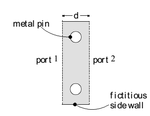Nassimovitch
Junior Member level 1

Hello,
Please, in the matlab command window How to solve the Helmoltz equation in the 2D space domain, in fact, I have to find proper functions and proper modes in an irregular geometry formed from a rectangle With two holes in the interior where the radius of holes and the width of the rectangle must change with each iteration.
thank you very much
Please, in the matlab command window How to solve the Helmoltz equation in the 2D space domain, in fact, I have to find proper functions and proper modes in an irregular geometry formed from a rectangle With two holes in the interior where the radius of holes and the width of the rectangle must change with each iteration.
thank you very much

